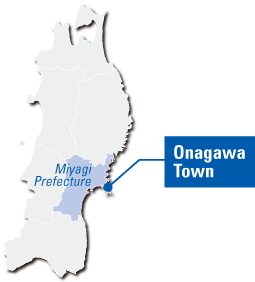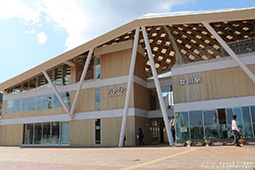

Onagawa Station was designed by Ban Shigeru. Inside the station building is the bathhouse Onagawa Onsen Yupo’po 
The central area of Onagawa Town immediately after the earthquake
May 2020
Tsunami Recovery and New Town Development

Heavily damaged by the tsunami which followed the Great East Japan Earthquake of March 2011, Onagawa Town in Miyagi Prefecture has achieved safety and renewed vigor by rebuilding its urban district in a compact form.

Onagawa Town in Miyagi Prefecture is located on the Pacific coast of the Tohoku region of northeast Japan, which is characterized by its many intricate small inlets and bays. An abundance of fishery products are caught year round off Onagawa in waters close to the island of Kinkasan, one of the world’s most productive fishing grounds. Onagawa has thus developed as a port town based on the fishing and marine product processing industries.
However, the Great East Japan Earthquake that occurred on March 11, 2011 inflicted devastating damage on the town. A tsunami close to 15 meters high left 827 people dead and missing among a population of about 10,000, and destroyed almost all the buildings along the coast.
About six months after the earthquake, the town decided on the restoration plans and started building a new port town based on the basic vision of disaster reduction. Before the earthquake, many residents of Onagawa lived on the limited area of flat land surrounded by mountains along the coast. To reestablish itself as a town where people can live in safety, the planners cut into the mountains, developed residential areas, raised the embankment of the flat land with the cut soil, concentrated educational, medical, transport, commercial and administrative centers around Onagawa Station, and reconstructed a compact central urban district. The intention was to reproduce a town that could continue to create liveliness, even amid the acceleration of depopulation, by concentrating the flows of people from residential areas to a central urban district.

Onagawa Station of Japan Railways reopened in March 2015, four years after the earthquake. The new station building, featuring a white roof based on an image of a black-tailed gull in flight, was designed by world-famous architect Ban Shigeru. Inside the station building is the hot spring facility Onagawa Onsen Yupo’po. The wall of the bathhouse is decorated with a beautiful tile painting by Senju Hiroshi, a renowned Japanese painter. An observation deck on the third floor affords a view of Onagawa Town and Onagawa Bay. Onagawa Station made a new start as the gateway to the town.
In addition, in December 2015, Seapal-Pier Onagawa, a commercial facility based on the concept of “a town with a park from which people can enjoy seeing the sea,” opened along a brick promenade linking Onagawa Station and the port of Onagawa, and in December 2016, Local Market Hama Terrace, a tourism and specialty store dealing in fresh fish, processed fishery products and other local specialties, also opened for business. These facilities are not only places where people both inside and outside the town can gather to enjoy the landscape surrounded by mountains and the sea, but also serve as landmarks on an evacuation route, a brick road leading to high ground in case of disaster.

Doi Hideki, an official of Onagawa Town, says, “Inside the two facilities, not only did business recommence after the earthquake, but new businesspeople from both inside and outside the town also established about thirty-five shops such as restaurants, souvenir shops and daily commodities shops. This has made the place livelier than it was before the earthquake.”
In February 2013, students from Onagawa Junior High School played a central role in launching the “Onagawa Inochinosekihi” project of building stone monuments, inscribed with lessons from the earthquake, at all twenty-one beaches in the town under the slogan of “Protecting lives 1,000 years on.” To date, twenty monuments have been built.
Construction of “Remnant from the Great East Japan Earthquake: The Former Onagawa Police Box” was completed in February 2020. The police box was the first reinforced concrete construction to be toppled by a tsunami in Japan, and a rare case worldwide. Onagawa Town wants to pass on to future generations the memories and lessons of the Great East Japan Earthquake as well as the people’s path out of despair toward recovery, and wishes that the people of the future won’t have to experience the same sadness and suffering. That is why this “Former Onagawa Police Box” was saved as a remnant of the disaster.
Nine years have passed since the Great East Japan Earthquake, and as new facilities and the town scenery are coming back to life, with fishery facilities, businesses, local government offices, lifelong learning centers and libraries in place, the people of Onagawa are united in heart and marching into the future with firm determination.

(This is a revised version of the article that appeared in the May 2019 issue of Highlighting Japan.)

